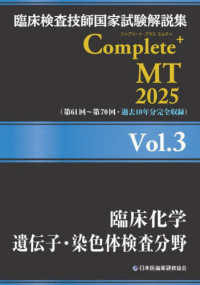- ホーム
- > 洋書
- > 英文書
- > Psychology
基本説明
New in paperback. Hardcover was published in 2007. Considers how social factors constrain the decoding of nonverbal bahaviour.
Full Description
The study of emotional expressions has a long tradition in psychology. Although research in this domain has extensively studied the social context factors that influence the expresser's facial display, the perceiver was considered passive. This 2007 book focuses on more recent developments that show that the perceiver is also subject to the same social rules and norms that guide the expresser's behavior and that knowledge of relevant emotion norms can influence how emotional expressions shown by members of different groups are perceived and interpreted. Factors such as ethnic-group membership, gender and relative status all influence not only emotional expressions but also the interpretation of emotional expressions shown by members of different groups. Specifically, the research presented asks the question of whether and why the same expressions shown by men or women, members of different ethnic groups, or individuals high and low in status are interpreted differently.
Contents
Introduction Pierre Philippot and Ursula Hess; 1. Implications of ingroup-outgroup membership for interpersonal perceptions: faces and emotion Jennifer Richeson, John F. Dovidio, J. Nicole Shelton and Michelle Hebl; 2. When two do the same, it might not mean the same: the perception of emotional expressions shown by men and women Ursula Hess, Reginald B. Adams, Jr and Robert E. Kleck; 3. It takes one to know one better: controversy about the cultural ingroup advantage in communicating emotion as a theoretical rather than methodological issue Hillary Anger Elfenbein; 4. Beauty is in the eyes of the perceiver: the impact of affective stereotyping on the perception of outgroup members' facial expressions Pierre Philippot, Yanélia Yabar and Patrick Bourgeois; 5. The perception of crying in women and men: angry tears, sad tears, and the 'right way' to cry Leah R. Warner and Stephanie A. Shields; 6. Tell me a story: emotional responses to emotional expression during leader 'storytelling' Kristi Lewis Tyran; 7. Apples and oranges: methodological requirements for testing a possible ingroup advantage in emotion judgments from facial expressions David Matsumoto; 8. Others' faces' tales: an integration Ursula Hess and Pierre Philippot.








